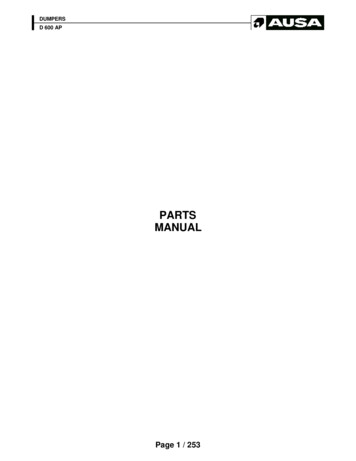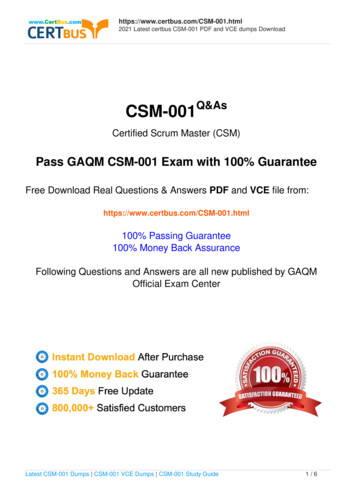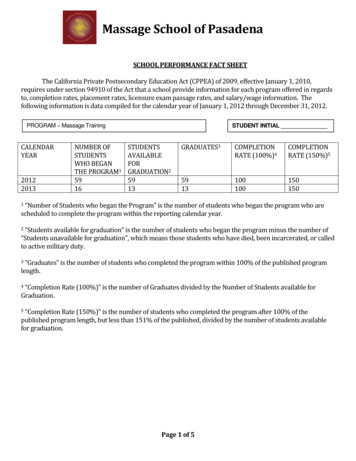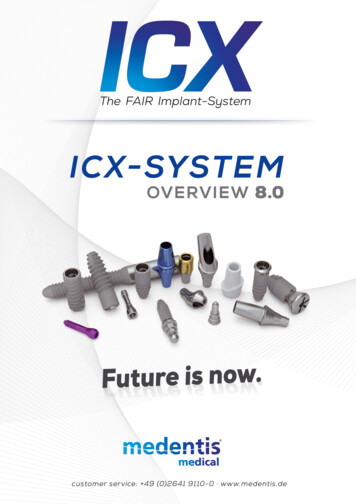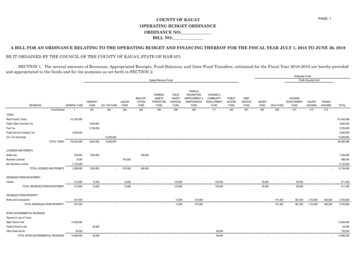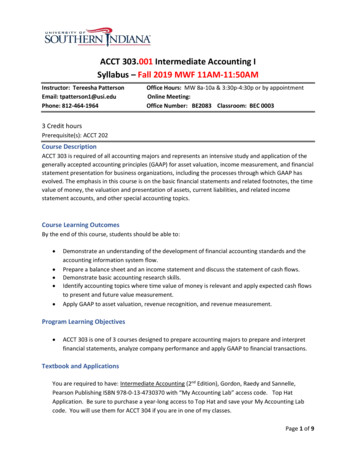
Transcription
Porsche OMERS & MaRKEtS Scania and Porsche Engineering – a very special collaborationPORScHE uP clOSE Master of curves: the new CaymanENGiNEERiNG iNSiGHtS More efficient software development through rapid control prototypingIssue 1 / 2013Engine development for the future
Complete Vehicle · Styling · Body & Safety · Engine · Drivetrain · Chassis · Electrics & Electronics · Testing · Industrial Engineering · Production EngineeringArguably the main technology centreat Porsche Engineering:the brains of our engineers.
Dear readers,Porsche. Engine. Two words that are inseparable.Looking at the example of the 911, we can see just what anextraordinary development an engine—in this case a flat-sixengine — goes through in 50 years. Throughout the yearsand to this day, engine developers have asked themselveshow much further the traditional combustion engine canbe developed. In this issue, Porsche Engineering Magazine examines this ever- fascinating subject and shows that enginedevelopment has not reached the end of the road — not byany stretch of the imagination.Malte Radmann and Dirk Lappe,Managing Directors of Porsche EngineeringAbout Porsche EngineeringCreating forward-looking solutions was the standardset by Ferdinand Porsche when he started his designoffice in 1931. In doing so, he laid the foundation fortoday’s engineering services by Porsche. We renewour commitment to that example with each new projectthat we carry out for our customers.The scope of services provided by Porsche Engineeringranges from the design of individual componentsto the planning and execution of complete vehicledevelopments, and is also transferred to other sectorsbeyond the automotive industry.On the one hand, there is the indefatigable drive of our engineers, which inspires them to grapple with the technicalchallenges presented by the field with each new day. On theother hand, changing conditions such as CO2 regulations,as well as evolving demand due to issues surrounding thesocial acceptance of vehicles and sports cars in particular,also influence our development work.But we don’t restrict ourselves exclusively to cars — we liketo test our mettle in other areas as well. In this issue we takea look at our collaboration with the commercial vehiclemanufacturer Scania.You can also look forward to learning about some tech nical details from the development of the new PorscheCayman as well as engineering insights about the “rapidcontrol prototyping” method, which facilitates an efficientand flexible model-based software development process.Generally we always keep an eye on trends and technologies: learn more about current developments and challenges in the field of aerodynamics / thermal managementas well as the continuous use of tolerance management asa preventive quality assurance method.We hope you enjoy this issueof Porsche Engineering M agazine.editorialPorsche Engineering Magazine3
30CUSTOMERS & MARKETSEVERYDAYEXTRAORDINARYWhat happens when a commercial vehicle manufacturer workstogether with a sports car developer? Find out more in the customerinterview with Scania.
NALYSIS243648ENGINE DEVELOPMENTCUSTOMERS & MARKETSENGINEERING INSIGHTS10 Endurance Testing: PracticeEngine testing for everyrequirement30 Everyday ExtraordinaryCooperation with the commercialvehicle manufacturer Scania42 Rapid Control PrototypingGreater efficiency in the softwaredevelopment process16 DownsizingLower fuel consumption withoutgiving up high performance22 It’s All in the MixInterview with Klaus Fuoss,head of engine developmentTRENDS AND TECHNOLOGIESPORSCHE UP CLOSE36 Third-Generation Master of CurvesThe new Porsche Cayman40 Passion for Safety and AestheticsPassive safety in the interiorof the new Porsche Cayman48 Aerodynamics and ThermalManagementRising requirements call forintelligent solutions03 Editorial06 News52 Imprint24 Dimensional Management inVehicle DevelopmentA preventive quality assurancemethod911 (TYPE 991) Fuel consumption (combined):12.4 – 8.2 l / 100 km; CO2 emissions: 289 – 194 g/kmCAYMAN Fuel consumption (combined):8.8 – 7.7 l / 100 km; CO2 emissions: 206 – 180 g/kmCONTENTSPorsche Engineering MAGAZINE5
NewsIntegrationin High GearChanges and improvements are steadilyadvancing the integration project at thePorsche Group’s Nardò Technical Centerin southern Italy. In addition to the longterm expansions and enhancements to thefacilities and tracks, both major and minorchanges are already evident. Appointmentof a technical managing director for theNardò Technical Center can be seen asyet another important milestone in theintegration process. Edmund Sander, whohas directed the drivetrain and suspensiondivision at Porsche Engineering for manyyears, will be in charge of the technicaldivisions and provide strong support toFrancesco Nobile, the Chairman of theManagement Board, who heads the commercial divisions. The Nardò TechnicalCenter will thus become an even morecrucial resource for external customer projects connected with Porsche’s engineeringservices than it already is today. nwww.porsche-nardo.com911 (TYPE 991) Fuel consumption (combined):12.4 – 8.2 l / 100 km; CO2 emissions: 289 – 194 g/km
NewsMotivated Employees fordevelopment projects“Vehicle Electronics”and “Testing Expo”measurementPortfolio ExpandedEmployee surveyTrade fairsNew processThe high degree of motivation withwhich Porsche Engineering employeestackle demanding customer projects is acrucial factor in the success of PorscheIntelligent Engineering. A recent poll ofemployees at Porsche Engineering hasconfirmed the positive results of pastsurveys. Employees are very motivatedand committed, and also view theirwork as meaningful, interesting, andvaried. In comparison to the last surveythe engineers’ identification with thecompany has increased yet again.Porsche Engineering commissioned anindependent company to carry out thesurvey — and the high rate of responseis yet another indication of the participatory culture at the company. nPorsche Engineering is continuingto take part in conferences and tradefairs in 2013, in order to engage indirect dialogue with representatives ofthe automotive and other sectors. Thebroad range of electric / electronic solutions offered by Porsche’s engineeringservice provider will be presented ata conference focusing on electronicsystems for motor vehicles, which willbe held by the Association of GermanEngineers (VDI) in Baden-Baden onOctober 16–17. The Nardò TechnicalCenter participated in the AutomotiveTesting Expo Europe in Stuttgart onJune 4–6 in order to present the facilityand its full range of services related todevelopment and testing. As always,Porsche Engineering can also be foundat a large number of personnel anduniversity fairs. More information isavailable at: www.porscheengineering.com/peg/en/jobs/events nPorsche Engineering is expandingits measurement portfolio in the enginedevelopment sector with the addition ofan innovative process for testing cylinder head designs. Ever higher efficiencyand performance requirements are causing ever greater demands to be placedon valve drives and their design with respect to variability. Porsche Engineeringis setting new standards here in analyzing the functions of multi-stage slidingcam systems that can optimize valvedisplacement for different operatingconditions. In addition to conventionalvalve drive dynamics, analysis focuseson the sliding paths of individual camsegments. Measurement technology including high-resolution optics is usedto register the sliding paths, and theactuating systems needed for the sliding processes are run by a real-timecontrol system developed by the company itself. nNEWSPorsche Engineering Magazine7
En gine ['ɛndʒən] Machine thatgenerates propulsive force throughthe conversion of energy.De vel op ment [dɪ'vɛləpmənt]The creation of (technical) objectsthrough directed considerations,trials and designs.Two words — one passion. Especially when combined. Engine development forthe future is one of the main tasks of the engineers at Porsche Engineering. Oneapproach is downsizing — reducing fuel consumption without having to forgotop performance. Not just development know-how, but also comprehensive testing equipment is necessary to meet the mobility challenges of the future. Wherewill the journey take us? Klaus Fuoss, head of engine development at PorscheEngineering, talks about the future of the combustion engine.8Porsche Engineering MAGAZINEENGINE DEVELOPMENT
ENGINE DEVELOPMENTPorsche Engineering MAGAZINE9
EnduranceTesting: PracticeDevelopments only provide added value when they have passed real-life testing.Testing within engine developments is therefore extremely important for a wide varietyof customer projects.By Dr. Matthias Bach, Johannes Wüst, and Robert KerresPhotos: Jörg Eberl, Gabriele Torsello, archive10Porsche Engineering MagazineENGINE DEVELOPMENT
Testing at the Weissach DevelopmentCenter: View of the engine acoustic chamber (left) and an engine on a testbench (right)Porsche has always been at the forefront of trends and technologies in thearea of engine development — both forits own sports cars and projects forexternal customers. But only when thetheory has been confirmed in practicedo the true benefits for the customercome through.located at a single site. It is possible totest the various drive variants, fromfront- and rear-wheel drive to all-wheeldrive engines. The infrastructure is alsoin place for efficient testing of hybridand electric motors.Diverse environmentsand short distancesA broad spectrum ofengine test benchesTo efficiently test the very differenttypes of engines, Porsche has a widerange of different test benches. Continu ous investment ensures that all Porschelocations always have state-of-the-arttechnology to meet the demands of increasing product complexity and changing legal frameworks, which also placemore stringent requirements on enginetesting and the test benches required forit. From small test benches for testingcomponents and systems to standard engine test benches and high-performancetest benches used for motor racing purposes, Porsche has everything centrallyTo simulate all of the different environmental conditions that an engine can beexposed to, the range of testing capabili ties includes the engine climate pressurechamber and the dynamic high-performance powertrain test bench, amongothers. These facilities enable simulationof different temperatures and pressuresto ensure that the engines can withstanda vast array of environmental conditions.In addition to the various test benchesand other testing capabilities, anotherimportant factor is the close proximity tothe specific departments and other areasand workshops. Short communicationpaths ensure direct exchange of expertiseand knowledge.ENGINE DEVELOPMENTCustomer-specificand multifunctionalPorsche Engineering also uses the testbenches to conduct customer projectsin a specific and efficient manner. Theindividual component test benches inparticular offer the opportunity to accommodate the requests of customersnot only from the automotive industrybut also other sectors.As the requirements for test equipmentin development for external customerscan vary widely from one project toanother, the test facility itself must bedesigned with the greatest degree ofvariability in mind. To meet that challenge, the test facility is equipped formultifunctional use and is extremelyflexible. This makes it possible to exe cute projects from different technological fields with great efficiency.›Porsche Engineering Magazine11
Porsche measurement technologyTo record measured values for test objects, all test benches utilize Porschedeveloped measurement technology(PMT), the fifth generation of whichis currently being rolled out. Thismakes it possible to employ any givencombination of different measurement modules for pressures, temperatures, voltages, and other variables. Themeasurement modules themselves aremobile and can also be used for measurements in the vehicle. Maintenanceand calibration tasks are executedcentrally at the Development Center inWeissach.The Laser Doppler vibrometer measures lift and speed.Intelligent test bench controlThe test bench control is capable ofsimulating motor functions of controlunits that will be implemented in seriesECUs (Engine Control Units) years later.One example is the variable valve-liftdevice, which controls valve-lift switching on engines in real time and with acrankshaft angle resolution of less thanone degree.Engineering has developed monitoringfunctions for some parameters that detect malfunctions within a five-degreecrankshaft angle, trigger an emergencystop, and thus minimize any follow-ondamages.With these highly dynamic applications, extremely fast measurement ofthe test object is of the essence: mechanical defects or malfunctions mustbe detected without delay. PorscheTo efficiently measure the dynamiccharacteristics of valve drive components, Porsche Engineering uses a testbench for taking measurements onmock-up cylinder heads. The cylinderDynamic valve drive measurementA transmission is mounted on the test bench.12Porsche Engineering MagazineENGINE DEVELOPMENThead along with the control assemblyis driven by a powerful asynchronousmotor. A Laser Doppler vibrometermeasures the lift and the speed of thevalves. Processing and evaluating thevalues recorded at sampling rates ofup to 400,000 Hertz makes it possibleto draw conclusions about maximumpermissible engine speeds, acousticdevelopment, wear, and loads on components. Other parameters such asoil pressures, temperatures, torsionalvibration, as well as signals from components applied with strain gauges arealso used.
The tilt test bench enablesbiaxial rotation of up to60 degrees in any direction.high-speed analysesIn many test applications, high-speedvideo cameras are used. This systemmakes it possible to visualize dynamiceffects such as the oscillation formsof chains, valve springs, or the axialmovements of cam segments in variablevalve trains and later analyze themwith image processing software.Thanks to the modular structure of thetest bench, in addition to valve drivemeasurements it is also possible to measure friction performance parameters onmotored engines, engine components,or transmissions. Here high-precisiontorque flanges and oil conditioning witha very high control precision are used.hybrid and electric motorsThe regenerative capability of the asynchronous motor in conjunction with amobile 60 kW DC power supply alsoenables testing of electric drives suchas belt alternator starters, for whichthe important breakaway torque atzero rpm as well as the efficiency in generation mode is determined.In light of the rising hybridization andelectrification of vehicles, the batterysimulation systems required for efficienttesting are already in use. There is alsoa 250 kW DC power supply availablethat provides the electric motors withENGINE DEVELOPMENTthe required power or feeds the generated electricity back into the grid whenworking in generator mode. To condition the electric motor and associatedpower electronics, a conditioning devicethat can test both systems separately atdifferent temperatures between – 40 degrees Celsius and 120 degrees Celsiusis used. To determine the efficiency oftest objects, an electrical power measurement device is utilized.Tilt test benchTo simulate cornering maneuvers orbraking and accelerating, engines canbe mounted on a tilt test bench andtested to maximum engine speeds tiltedup to 60 degrees over horizontal in alldirections. The tilt test bench itself isattached to an air-suspension test bedframe with a leveling system, which inits lowered position is covered by platesand thus enables a level surface. In thesetilting tests, the quality of oil aerationmeasurements is given particular attention.Measurement of industrial enginesIn testing industrial engines, thermodynamic measurement plays an importantrole. Engines for emergency generators,lawn mowers, or manually operated forestry equipment require a special type oftesting that impacts the preparation ›Porsche Engineering Magazine13
ADA test bench for testing exhaust emissionsof the test benches and the measuringprocedure. The displacement can rangefrom 25 cm³ to roughly 500 cm³. Eddycurrent brakes are used for the measurement of engine torque, while fuel consumption is measured gravimetrically.Exhaust sensorsExhaust gas measurement systems are inplace to analyze exhaust gas. These systems extract very small sample amountsfrom the test object to avoid impactingthe gas charge cycle, particularly in thecase of 2-stroke engines.protection, vehicles are subjected tocomprehensive emissions testing. Inthis regard Porsche has engaged in along-standing collaboration with theAbgaszentrum der Automobilindustrie(ADA), the German exhaust emissions center for the automotive industry, for which Porsche operates specialtest benches. These include a hydraulicshock test bench with which protectivetubes from AFR (Air Fuel Ratio) andNOx sensors are analyzed, as well as atest bench for the evaluation of particlesensors.design of the test benches and the fastconfigurability of the measurement technology make it possible to implementa vast range of tests, either for sportscars or other challenges. And when thedevelopment has proven its success intesting, there’s just one more thing: thefirst test drive on the track Challenges are welcomeTo ensure that engine developmentsalso fulfill customer-specific and legalrequirements with regard to exhaust gasand emissions, more precise exhaust gassensors can be utilized. In the PorscheEngineering center for environmental14Porsche Engineering MagazineThe special thing about the Porsche engine testing facility is its wide applicability: both in terms of capability andflexible structure, it has all the prerequisites for efficient testing. The flexibleENGINE DEVELOPMENT911 (TYPE 991) Fuel consumption (combined):12.4 – 8.2 l / 100 km; CO2 emissions: 289 – 194 g/km
time for the track!The Nardò Technical Center in southern Italy, which was acquired by Porschein April 2012, offers ideal conditions for engine testing on the track and otherpurposes. Due to the special climatic conditions, standard tests (for example ofthe oil circuit, engine ventilation, or engine cooling) in stationary and dynamicdriving modes can be carried out year-round. The proving ground enablesthe execution of comprehensive endurance drives as well as testing in extremeconditions. In particular in summer when extreme temperatures predominate inApulia, the developments are pushed to the limit. And application testing ofconditions such as high-speed scenarios, checking the basic engine application,the knock control dynamics test, and on-board diagnosis are all possible yearround at Nardò. Everything needed for special measurements in the vehicle,torque and torsional vibration measurements, and no-contact measurementof the exhaust valve temperature are on hand at the facility as well. Once atest object has withstood testing in Nardò as well, the end of the developmentprocess and ultimately its debut on the road are well within sight. n
High specific power, a wide speed range with maximumtorque and good transient behavior — these are the maincharacteristics that distinguish modern downsizing engines.In the future it will be necessary to reduce the fuel enrichmentin order to achieve further fuel savings in customer-relevantoperation. The engineers at Porsche Engineering are conductingvarious simulation studies in order to reduce fuel consumptionwithout any loss of maximum vehicle performance.By Eric Jacobs,Vincenzo Bevilacqua,and Gerd Grauli911 (TYPE 991) Fuel consumption (combined):12.4 – 8.2 l / 100 km; CO2 emissions: 289 – 194 g/km16Porsche Engineering MagazineENGINE DEVELOPMENT
Throughout the more than 35-year history of Porsche turbovehicles, Porsche development engineers have been able to usevarious technologies (such as the optimization of the gas exchange using VarioCam Plus technology and introducing directfuel injection) to double the engine power and the maximumtorque while reducing fuel consumption significantly.The difficultyThe requirements for charged SI engines lead to conflictinggoals when laying out exhaust turbochargers. On the onehand, a larger exhaust turbocharger is meant to achieve a highoutput, while on the other hand the maximum torque shouldbe reached even at low engine speeds without creating theimpression of a turbo lag.Downsizing in engine developmentFor quite a while now, Porsche Engineering has focused ondeveloping engines with lower fuel consumption and increasedefficiency. Reducing the displacement in spark ignition (SI)engines is an effective option to increase efficiency. In particular, this trend can be observed in the engines currently availableon the market.As engine load increases, there is a reduction in the pumpinglosses and in the percentage of friction. An analysis ofstate-of-the-art engines shows that if the driving dynamics andpower remain constant, the displacement can be reduced byaround 25 percent to enable fuel savings of around 20 percent.The goals of current engine developments are improving thetransient behavior in combination with high engine power, awide speed range with maximum torque, a reduction in fuelconsumption in accordance with the New European DrivingCycle (NEDC), and in customer-relevant operation.Small turbochargers are necessary to achieve an early, dynamic response. They create higher exhaust gas back pressurewithin the defined power range. The increased tendency toknocking in turbocharged engines due to the increased temperature and pressure values in the combustion chamber isfurther increased by the larger residual gas content. In consequence, there is a later ignition timing necessary, resulting inan increased exhaust gas temperature.Knocking and the component temperature limits define the lineof turbocharging. To ease these limitations, fuel enrichmenthas become an established practice in modern, turbochargedengines.For high engine loads, and for vehicles with high rollingresistance, the benefits of an increased downsizing level arereduced due to earlier and more intensive fuel enrichment.In a customer-oriented driving profile, the positive effect of ›Market overview for current SI engines140.0Spec. output (kW / l)120.0Due to engine downsizing,high specific output is possiblewith reduced displacement.100.080.060.040.020.00.001Exhaust turbocharger2345Displacement (l)Mechanical chargerTwin charger67 8Normally aspirated engineENGINE DEVELOPMENTPorsche Engineering Magazine17
Lambda25.00LambdaMax. torqueKnockingTorque (Nm)Component protectionEff. mean pressure 001000Engine speed (rpm)200030004000500060006750Engine speed (rpm)Limitations of single-step exhaust turbochargingLambda engine characteristic map of a 1.6-liter turbo enginewith mechanical chargerthe higher downsizing level can even be reversed. Increasingthe efficiency requires new technologies for expanding the areawith an optimal air-fuel ratio.In customer cycle B, with higher load cycles, the fuel savingsare only 9 percent. The use of components resistant to hightemperatures, a cooled exhaust manifold, cooled inert-gasrecirculation, and water injection is intended to reduce thefuel enrichment to protect components and avoid knocking.The simulation modelThe reference engine used is a 6-cylinder 2.9 liter normallyaspirated engine with an output of 195 kW and maximumtorque of 300 Nm. By means of the 1D gas exchange simulations, this engine is compared with a turbocharged 3-cylinderengine with 1.6-liter displacement. With turbocharging, thesame power output can be achieved. To improve the transientbehavior at low engine speeds, a mechanically driven supercharger is used whose characteristics are analyzed in variousdriving maneuvers using a coupled vehicle-engine simulationmodel. It is possible to reduce the fuel consumption in theNEDC by up to 27 percent while keeping the same drivingdynamics.In driving cycles with higher load cycles, the negative effect ofthe earlier and more intensive fuel enrichment becomes obvious. For example, in customer cycle A — which correspondsto a cross-country profile—the benefit is reduced to 14 percent.18Porsche Engineering MagazineCooled exhaust gas recirculationCooled exhaust gas recirculation is a standard-productionapplication for diesel engines. In the simulation carried out, twodifferent concepts are analyzed. With low-pressure exhaustgas recirculation (LP EGR), the exhaust gas is extracted afterthe turbine wheel and reintroduced ahead of the compressorwheel. With high-pressure exhaust gas recirculation (HP EGR),the exhaust gas is extracted before the turbine wheel andreintroduced after the compressor wheel.Using low-pressure exhaust gas recirculation has slight advantages compared to high-pressure exhaust gas recirculation.Overall, both concepts can achieve maximum fuel consumption savings of 12 percent for the engine used. However,the knocking tendency cannot be reduced using cooled inertgas recirculation.›ENGINE DEVELOPMENT
Analysis shows that for current engines,assuming that the driving dynamics andoutput are unchanged, it is possible to reducethe displacement by around 25 percent.As a result, fuel consumption savings of around20 percent can be achieved.
Specificfuel consumption(g / kWh)Fuel consumption potential throughcooled exhaust gas recirculation andcooled exhaust manifoldLambda (–)FCI 9.3 %0,900,850,800,750,70FCI engine characteristic map LPEngine speed (rpm)Engine speed (rpm)FCI .0010.0011.0012.0013.00A cooled exhaust manifold is used in a number of currentturbocharged SI engines. Simulations with the turbocharged1.6-liter engine show that it is possible to reduce the fuel enrichment. However, complete avoidance of fuel enrichmentwould be difficult as the manifold would have to dissipate verysignificant heat flows. Extending the optimal air-fuel ratio arearesults in recognizable fuel savings. But due to the reducedinternal cooling, it is necessary to move the ignition timing toa later point due to the increased knocking tendency causingan increased exhaust gas temperature. Another disadvantage:the engine efficiency loss must be compensated with increasedcharge pressure resulting in higher turbocharger speed, inorder to generate the same engine power. In the lower speedrange it is not possible to reduce the knocking tendency byusing this technology.High-temperature materialsMaterials resistant to high temperatures are series-productionfeatures in turbocharged SI engines. This technology allowshigher exhaust gas temperatures. Therefore, the fuel enrichment can be reduced in the simulation, but cannot be avoidedcompletely. As with the cooled exhaust manifold, there are no20Porsche Engineering Magazine HF 20 kwWall temperature of exhaust manifold (K)n 5000 1 / min pme 24 barFuel consumption improvements (FCI) through cooled exhaust gas recirculationCooled exhaust manifoldp50p50GrenzelineCombustioncenter point( KWnOT)FCI engine characteristic map HPbmep (bar)low-pressureEXHAUST GAS RECIRCULATIONbmep (bar)high-pressureEXHAUST GAS RECIRCULATIONHeat flow of exhaust manifold (kW)0,65Potential of a cooled exhaust manifoldbenefits for the knocking tendency in the lower engine speedrange with high loads. The difficulty of reduced internal cooling also occurs with this system. The shift of the ignitiontiming also requires increased charge pressure by means of anincreased turbocharger speed to compensate for the lowerengine efficiency. Using high-temperature materials enablesthe optimal air-fuel ratio to be extended, but — as with thecooled exhaust manifold — it leads indirectly to loweredcombustion efficiency.Water injectionUsing water injection is familiar from motor sports, but it isnot currently a series production feature of a turbochargedengine. It is possible to introduce water at various points intothe turbocharged engine system.In the simulation model, the introduction of water into boththe intake manifold and exhaust manifold can be analyzed.The latter reduces the fuel enrichment required, but cannotcompletely prevent it in the simulated engine. Additionally,with this position the need for water is increased. The reduced internal cooling results in the same disadvantages asarise when using a cooled exhaust manifold or hightemperature materials. Because of the later ignition timing,ENGINE DEVELOPMENT
Higher exhaust gas temperatures are madepossible by high-temperature materials.The technology of water injection—familiarfrom motor sports—enables further fuelconsumption savings.262524232221Lambda (–)1.21.1Effective mean pressure(bar)n 5000 1 / min – pme 24 bar1.00.90.7400350Engine speed (rpm)Engine speed (rpm)t3 920 Ct3 1020 C300Combustion center point( KWnOT)lambdabmep (bar)bmep (bar)lambda2502003015025Specific fuel consumption(g / kWh))0.8201510Injected water massInjected fuel massExhaust manifold injectionIntake manifold injectionCharacteristic lambda map with and without high-temperature materialsPotential of water injectiondue to the increased knocking tendency the turbochargerspeed comes closer to its speed limit and there is an increasein the exhaust gas pressure.and currently provide a good and simple option for reducing the fuel enrichment requirement in customer-relevantdriving cycles.In the case of water injection into the intake manifold, astoichiometric air-fuel ratio can be used in the entire application area. In contrast to the other technologies analyzed, theengine efficiency can be increased due to an optimal ignitiontiming. This applies to both the knocking-sensitive area at low
EDITAL Porsche Engineering AAE 3 About Porsche Engineering Creating forward-looking solutions was the standard set by Ferdinand Porsche when he started his design office in 1931. In doing so, he laid the foundation for today’s engineering services by Porsche. We r
